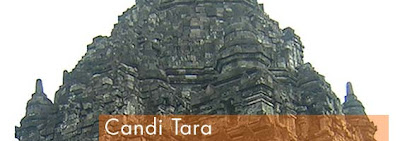
Most
people will mention Borobudur when talking about Buddhism temples.
Whereas, there are many other Buddhism temples in Yogyakarta; one of
them that is closely related to Borobudur is Tara temple. This temple
that is located in Kalibening village in Kalasan was built by the same
person who conceptualized Borobudur temple, namely Rakai Panangkaran.
Since it is located in Kalasan area, this temple is popular with the
name of Kalasan temple.
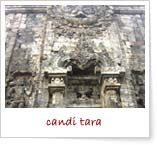
Completed
in 778 AD, Tara temple becomes the oldest Buddhism temple in
Yogyakarta. This temple that is situated close to Yogya-Solo Street was
a present of the marriage of Pancapana of Sanjaya dynasty to Dyah
Pramudya Wardhani of Syailendra dynasty. In addition to a marriage
present, the temple was also realization of the kings’ proposal to
build another holy temple for goddess Tara and a monastery for the
monks.
Tara temple is a building in the form of a cube with the
size of each side of 45 meters and 34 meters high. Vertically, this
temple consists of three parts, namely temple foot, temple body and
temple roof. The foot of the temple is a building on square stones and
a wide stone. On this part, there is a stair with makara ornament at
the end. Meanwhile, around the temple foot there are ornaments of
climbing plants that come out from pots.
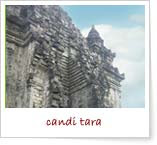
The
body of the temple protrudes at the central side. At the outer surface
of the temple body, a hollow is ornamented with a standing goddess
holding lotus. In southeast part, there is a small room with throne
ornamented with the motif of a lion standing on an elephant’s back. The
room can be accessed from the other room at the east side.
The
roof of the temple is octagonal and consists of two stories. An effigy
describing Buddha is located in the first story while on the second
story there is a statue describing Yani Buddha. The top of the temple
is a square symbolizing Semeru summit with ornaments of domes. At the
interface of the temple body and the roof, there is a flower ornament
of a dwarf named Gana.
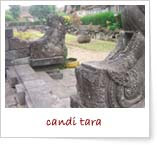
If
you observe the temple in detail, you will also find beautiful relief
on its surface; for example, relief of tree of god and cloud and the
dwellers of the heaven producing sounds. The dwellers of the heaven
hold rebab (two-stringed music instrument), shell, and camara. There
are also ornaments of flowers, leaves and climbing plants. Relief at
Tara temple is typical since they are coated with special cement called
Brajalepha, made from sap of certain tree.
Around the temple,
there are 52 domes as high as around 4.6 meters. Even though those
domes are not intact anymore, since some parts are missing, you can
still enjoy them. Visiting this temple of which construction history is
known from Candi inscription in Panagari letters, you will acknowledge
the greatness of Rakai Panangkaran who even had the opportunity to
build a holy building in Thailand.
This
temple also proves that in the past there was
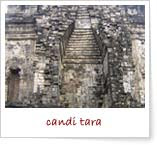
an effort to unite people
of different religions. The proof is that Panangkaran who was a Hindu
built the Tara temple in response to the proposal of Buddhism monks to
be presented to Pancapana who is also a Buddhist. This temple is also
one of the holy buildings that inspired Atisha, a Buddhist from India
who once visited Borobodur and spread Buddhism to Tibet.





